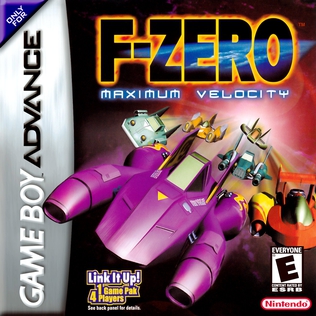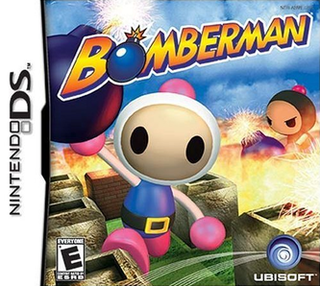
F-Zero: Maximum Velocity is a futuristic racing game developed by NDcube and published by Nintendo as a launch game for the Game Boy Advance. It was released in Japan, North America and Europe in 2001. It was the first F-Zero game released on a handheld game console.

Mario Kart: Super Circuit is a 2001 kart racing game for the Game Boy Advance (GBA). It is the third Mario Kart game and retains its predecessors' gameplay: as a Mario franchise character, the player races opponents around tracks based on locales from the Super Mario platform games. Tracks contain obstacles and power-ups that respectively hamper and aid the player's progress. Super Circuit includes various single-player and multiplayer game modes, including a Grand Prix racing mode and a last man standing battle mode.

Bomberman is a 2005 video game developed by Racjin for the Nintendo DS. It was released by Hudson Soft in Japan on May 26, 2005, and published worldwide by Ubisoft. The game is notable for its chibi art style, previously seen in the Bomberman Land series.

WarioWare: Twisted! is a video game for the Game Boy Advance, developed by Nintendo SPD with Intelligent Systems and published by Nintendo. It was released on October 14, 2004 in Japan; May 19, 2005 in Australia; and May 23, 2005 in North America. The second game in the WarioWare series and the seventh in the Wario series overall, Twisted! was the last Wario game to be released on a Game Boy family system.

It's Mr. Pants is a puzzle video game developed by Rare and published by THQ for the Game Boy Advance. It was released in North America in 2004 and Europe in 2005. A port of the game for mobile phones was developed and published internationally by In-Fusio in 2005–2006. The game stars Mr. Pants, a crudely drawn mascot formerly featured on Rare's website who had made cameo appearances in several prior Rare games.

Sonic Shuffle is a Sonic the Hedgehog-themed party game developed and published by Sega for the Dreamcast in 2000. The game plays like a board game much in the same vein as Nintendo's Mario Party series, with up to four players moving their characters across a game board filled with a variety of spaces which can trigger different events. Some spaces will launch minigames that pit the players against each other in short competitive events.

Bomberman Generation is a 2002 video game released for the GameCube. It was followed up by Bomberman Jetters.

Ms. Pac-Man Maze Madness is a maze chase video game developed and published by Namco for the PlayStation in 2000. It was later released for the Nintendo 64, Dreamcast, and Game Boy Advance. A remake of Ms. Pac-Man (1982), players control the titular character in her quest to stop a witch named Mesmerelda from stealing the Gems of Virtue. The game was well-received upon release, with critics applauding its simplicity and faithfulness to the arcade original. A sequel was in development around 2006, but was cancelled for unknown reasons.

Konami Krazy Racers is a 2001 kart-themed racing video game published and developed by Konami for the Game Boy Advance, released as a launch title for the system. Konami Krazy Racers makes use of a variety of characters and concepts from several of Konami's franchises, including Castlevania, Metal Gear, and Gradius. It plays similarly to the Mario Kart series, with eight characters per circuit and offensive/defensive items placed at predetermined points in the tracks. Konami Krazy Racers received mostly positive reviews. It was later released through the Virtual Console for Wii U in 2015.

Bomberman Jetters is an action game for the Game Boy Advance, GameCube and PlayStation 2, and part of Hudson Soft's Bomberman series. The game builds on the gameplay style established in the previous Bomberman series entry, 2002's Bomberman Generation, and features characters and settings from the 2002 anime series Bomberman Jetters. The GameCube version utilizes cel-shaded graphics similar to those of Bomberman Generation, while the PlayStation 2 version does not.

Dave Mirra Freestyle BMX 2 is a 2001 BMX video game developed by Z-Axis and published by Acclaim Entertainment under their Acclaim Max Sports label. It is the sequel to Dave Mirra Freestyle BMX. It was released for the PlayStation 2 in August 2001, and in the following months it was ported to the GameCube, Game Boy Advance, and Xbox video game systems. Both the GameCube and Xbox ports featured two extra levels that were not present in the PS2 version.

4x4 Evo 2, also known as 4x4 Evolution 2, is a racing video game developed by Terminal Reality for the PlayStation 2, Xbox, GameCube, Microsoft Windows, and Mac. It is the sequel to 4x4 Evolution and features more trucks and more racing tracks than the original game.

GT Advance Championship Racing, known in Japan as Advance GTA, is a racing game developed by MTO and published by THQ. It was a launch title for the Game Boy Advance. The game's sequel, GT Advance 2: Rally Racing, was released on June 30, 2002 in North America.

Mat Hoffman's Pro BMX is a 2001 BMX video game developed by Shaba Games and the first game to be published by Activision under the Activision O2 label. It is similar to the Tony Hawk's series and competed directly with Acclaim Entertainment's Dave Mirra Freestyle BMX. Despite a planned release in fall of 2000, the game was released in 2001 for the PlayStation and Game Boy Color, followed by Dreamcast, Microsoft Windows and Game Boy Advance. The PlayStation and Dreamcast versions received "favorable" reviews, while the PC and Game Boy Advance versions received "average" reviews. A sequel, Mat Hoffman's Pro BMX 2, was released in 2002.

Pinobee: Wings of Adventure, known in Japan as Pinobee no Daibōken or Pinobee: Quest of Heart, is a platformer for the Game Boy Advance, developed by Artoon and published by Hudson Soft. The game was released as a launch title for the system, on March 21, 2001 in Japan and June 11, 2001 in North America. A version was developed for PlayStation in 2002, simply titled Pinobee outside Japan.

Bomberman Land Touch! is a puzzle video game developed by Hudson Soft for the Nintendo DS. The game was first released in Japan and North America in 2006. Part of the Bomberman franchise, Touch! is the third game in the Bomberman Land series and its first to be released outside Japan.

Fire Pro Wrestling is a professional wrestling video game in the Fire Pro Wrestling series and was the first Fire Pro game to receive an official English translation and the first to be released on a portable system rather than a console. A direct sequel, Fire Pro Wrestling 2, was released in 2002.

Bomberman Land Touch! 2 is a puzzle video game for the Nintendo DS released in Japan on July 19, 2007, and in North America, Europe, and Australia in 2008. Part of the Bomberman franchise, it is the sequel to Bomberman Land Touch! and the seventh game in the Bomberman Land series.

Namco Museum is a 2001 video game compilation developed by Mass Media and published by Namco for the Game Boy Advance. It contains ports of five of their classic arcade games, Ms. Pac-Man, Pole Position, Dig Dug, Galaga, and Galaxian.



















